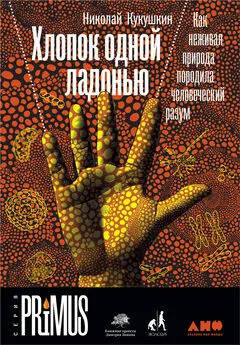Николай Кукушкин - Хлопок одной ладонью
- Название:Хлопок одной ладонью
- Автор:
- Жанр:
- Издательство:Альпина нон-фикшн
- Год:2020
- Город:Москва
- ISBN:978-5-0013-9315-3
- Рейтинг:
- Избранное:Добавить в избранное
-
Отзывы:
-
Ваша оценка:
Николай Кукушкин - Хлопок одной ладонью краткое содержание
Оказывается, в человеческом страдании виноваты динозавры, легкие существуют благодаря лишайникам, а главным событием в жизни наших предков за последний эон было превращение в червей. «Хлопок одной ладонью» – это история человека и его внутреннего мира, вмещающая в себя весь путь от неорганических молекул до возникновения языка и рассказанная так, будто это рыцарский роман или мифический эпос.
Хлопок одной ладонью - читать онлайн бесплатно ознакомительный отрывок
Интервал:
Закладка:
32. Rosenzweig, M. R., Breedlove, S. M. & Watson, N. V. Biological psychology: An introduction to behavioral and cognitive neuroscience, 4th edn (Sinauer Associates, 2005).
33. Herculano-Houzel, S. et al. The elephant brain in numbers. Front Neuroanat 8, 46, doi:10.3389/fnana.2014.00046 (2014).
34. Herculano-Houzel, S. The human brain in numbers: a linearly scaled-up primate brain. Front Hum Neurosci 3, 31, doi:10.3389/neuro.09.031.2009 (2009).
35. Herculano-Houzel, S. The remarkable, yet not extraordinary, human brain as a scaled-up primate brain and its associated cost. Proc Natl Acad Sci USA 109 Suppl 1, 10661–10668, doi:10.1073/pnas.1201895109 (2012).
36. Dunbar, R. I. & Shultz, S. Evolution in the social brain. Science 317, 1344–1347, doi:10.1126/science.1145463 (2007).
37. Dunbar, R. I. M. The social brain hypothesis. Evolutionary Anthropology: Issues, News, and Reviews 6, 178–190, doi:10.1002/(SICI) 1520–6505 (1998) 6:5<178::AID-EVAN5>3.0. CO; 2–8 (1998).
38. The World of Air Transport in 2018 , < https://www.icao.int/annual-report-2018/Pages/the-world-of-air-transport-in-2018.aspx> (2018).
39. Cartmill, M. in Primate Evolution and Human Origins 14–21 (Routledge, 2017).
40. Bloch, J. I. & Boyer, D. M. Grasping primate origins. Science 298, 1606–1610, doi:10.1126/science.1078249 (2002).
41. Ross, C. F., Hall, M. I. & Heesy, C. P. in Primate origins: Adaptations and evolution 233–256 (Springer, 2007).
42. Heesy, C. P. & Hall, M. I. The nocturnal bottleneck and the evolution of mammalian vision. Brain Behav Evol 75, 195–203, doi:10.1159/000314278 (2010).
43. Jacobs, G. H. Evolution of colour vision in mammals. Philos Trans R Soc Lond B Biol Sci 364, 2957–2967, doi:10.1098/rstb.2009.0039 (2009).
44. Hall, M. I., Kamilar, J. M. & Kirk, E. C. Eye shape and the nocturnal bottleneck of mammals. Proc Biol Sci 279, 4962–4968, doi:10.1098/rspb.2012.2258 (2012).
45. Heesy, C. P. Seeing in stereo: The ecology and evolution of primate binocular vision and stereopsis. Evolutionary Anthropology: Issues, News, and Reviews 18, 21–35, doi:10.1002/evan.20195 (2009).
46. Shamay-Tsoory, S. G. & Abu-Akel, A. The Social Salience Hypothesis of Oxytocin. Biol Psychiatry 79, 194–202, doi:10.1016/j.biopsych.2015.07.020 (2016).
47. De Dreu, C. K., Greer, L. L., Van Kleef, G. A., Shalvi, S. & Handgraaf, M. J. Oxytocin promotes human ethnocentrism. Proc Natl Acad Sci USA 108, 1262–1266, doi:10.1073/pnas.1015316108 (2011).
48. De Dreu, C. K. et al. The neuropeptide oxytocin regulates parochial altruism in intergroup conflict among humans. Science 328, 1408–1411, doi:10.1126/science.1189047 (2010).
49. de Menocal, P. B. African climate change and faunal evolution during the Pliocene – Pleistocene. Earth and Planetary Science Letters 220, 3–24, doi: https://doi.org/10.1016/S0012-821X (04) 00003–2(2004).
50. Cerling, T. E. et al. Global vegetation change through the Miocene/Pliocene boundary. Nature 389, 153–158, doi:10.1038/38229 (1997).
51. Elton, S. The environmental context of human evolutionary history in Eurasia and Africa. J Anat 212, 377–393, doi:10.1111/j.1469–7580.2008.00872.x (2008).
52. Darwin, C. The descent of man: and selection in relation to sex (J. Murray, 1871).
53. Lovejoy, C. O. Evolution of human walking. Scientific American 259, 118–125 (1988).
54. Milton, K. A hypothesis to explain the role of meat‐eating in human evolution. Evolutionary Anthropology: Issues, News, and Reviews: Issues, News, and Reviews 8, 11–21 (1999).
55. Stanford, C. B. & Bunn, H. T. Meat-eating and human evolution (Oxford University Press, 2001).
56. Carvalho, S. et al. Chimpanzee carrying behaviour and the origins of human bipedality. Curr Biol 22, R180–181, doi:10.1016/j.cub.2012.01.052 (2012).
57. Wheeler, P. E. The evolution of bipedality and loss of functional body hair in hominids. Journal of Human Evolution 13, 91–98, doi: https://doi.org/10.1016/S0047–2484 (84) 80079–2(1984).
58. Falk, D. Brain evolution in Homo: The «radiator» theory. Behavioral and Brain Sciences 13, 333–344, doi:10.1017/S0140525X00078973 (1990).
59. Langdon, J. H. Umbrella hypotheses and parsimony in human evolution: a critique of the Aquatic Ape Hypothesis. J Hum Evol 33, 479–494, doi:10.1006/jhev.1997.0146 (1997).
60. Balter, M. Becoming human. What made humans modern? Science 295, 1219–1225, doi:10.1126/science.295.5558.1219 (2002).
1. Robinson, W. S. in The Routledge Handbook of Consciousness 51–63 (Routledge, 2018).
2. Travis, J. Glia: the brain's other cells. Science 266, 970–973 (1994).
3. Magistretti, P. J. Neuron-glia metabolic coupling and plasticity. J Exp Biol 209, 2304–2311, doi:10.1242/jeb.02208 (2006).
4. Panatier, A. et al. Glia-derived D-serine controls NMDA receptor activity and synaptic memory. Cell 125, 775–784, doi:10.1016/j.cell.2006.02.051 (2006).
5. Aloisi, F. Immune function of microglia. Glia 36, 165–179, doi:10.1002/glia.1106 (2001).
6. Graeber, M. B. Changing face of microglia. Science 330, 783–788, doi:10.1126/science.1190929 (2010).
7. Pardridge, W. M. Transport of nutrients and hormones through the blood-brain barrier. Diabetologia 20, 246–254 (1981).
8. Kandel, E. R. Principles of neural science (2013).
9. Meissner, H. P. & Schmelz, H. Membrane potential of beta-cells in pancreatic islets. Pflugers Arch 351, 195–206, doi:10.1007/bf00586918 (1974).
10. Wood, D. C. Action spectrum and electrophysiological responses correlated with the photophobic response of Stentor coeruleus. Photochemistry and photobiology 24, 261–266 (1976).
11. Wood, D. C. Electrophysiological studies of the protozoan, Stentor coeruleus. Journal of neurobiology 1, 363–377 (1969).
12. Nickel, M. Evolutionary emergence of synaptic nervous systems: what can we learn from the non-synaptic, nerveless Porifera? Invertebrate Biology 129, 1–16, doi:10.1111/j.1744–7410.2010.00193.x (2010).
13. Brenner, E. D. et al. Plant neurobiology: an integrated view of plant signaling. Trends in Plant Science 11, 413–419, doi: https://doi.org/10.1016/j.tplants.2006.06.009(2006).
14. Satterlie, R. A. & Spencer, A. N. in Nervous systems in invertebrates 213–264 (Springer, 1987).
15. Hulbert, A. J. & Else, P. L. Comparison of the «mammal machine» and the «reptile machine»: energy use and thyroid activity. Am J Physiol 241, R350–356, doi:10.1152/ajpregu.1981.241.5. R350 (1981).
16. Dibrova, D. V., Galperin, M. Y., Koonin, E. V. & Mulkidjanian, A. Y. Ancient Systems of Sodium/Potassium Homeostasis as Predecessors of Membrane Bioenergetics. Biochemistry (Mosc) 80, 495–516, doi:10.1134/S0006297915050016 (2015).
17. Venkatesh, B. et al. Genetic basis of tetrodotoxin resistance in pufferfishes. Curr Biol 15, 2069–2072, doi:10.1016/j.cub.2005.10.068 (2005).
18. Soong, T. W. & Venkatesh, B. Adaptive evolution of tetrodotoxin resistance in animals. Trends Genet 22, 621–626, doi:10.1016/j.tig.2006.08.010 (2006).
19. Ballard, D. H. Brain computation as hierarchical abstraction (MIT Press, 2015).
20. Nickerson, R. S. & Adams, M. J. Long-term memory for a common object. Cognitive Psychology 11, 287–307, doi: https://doi.org/10.1016/0010–0285 (79) 90013–6(1979).
21. Goldstein, A. G. & Chance, J. E. Visual recognition memory for complex configurations. Perception & Psychophysics 9, 237–241, doi:10.3758/BF03212641 (1971).
22. Miller, N. & Campbell, D. T. Recency and primacy in persuasion as a function of the timing of speeches and measurements. The Journal of Abnormal and Social Psychology 59, 1–9, doi:10.1037/h0049330 (1959).
23. Mackay, D. G. et al. Relations between emotion, memory, and attention: Evidence from taboo Stroop, lexical decision, and immediate memory tasks. Memory & Cognition 32, 474–488, doi:10.3758/BF03195840 (2004).
24. Simons, D. J. & Chabris, C. F. Gorillas in our midst: sustained inattentional blindness for dynamic events. Perception 28, 1059–1074, doi:10.1068/p281059 (1999).
25. Kukushkin, N. V. & Carew, T. J. Memory Takes Time. Neuron 95, 259–279, doi:10.1016/j.neuron.2017.05.029 (2017).
26. Kukushkin, N. V. Taking memory beyond the brain: Does tobacco dream of the mosaic virus? Neurobiol Learn Mem 153, 111–116, doi:10.1016/j.nlm.2018.01.003 (2018).
27. Denes, A. S. et al. Molecular architecture of annelid nerve cord supports common origin of nervous system centralization in bilateria. Cell 129, 277–288, doi:10.1016/j.cell.2007.02.040 (2007).
1. Платон. Собр. соч. В 4 т. Т. 3 . – М.: Мысль, 1994.
2. Siegel, R. E. Principles and Contradictions of Galen's Doctrine of Vision. Sudhoffs Archiv 54, 261–276 (1970).
3. Sabra, A. I. The Optics of Ibn Al-Haytham: Books I–III: on Direct Vision (Warburg Institute, University of London, 1989).
4. Gregg, V. R., Winer, G. A., Cottrell, J. E., Hedman, K. E. & Fournier, J. S. The persistence of a misconception about vision after educational interventions. Psychonomic Bulletin & Review 8, 622–626 (2001).
5. Thibodeau, P. Ancient Optics: Theories and Problems of Vision. A Companion to Science, Technology, and Medicine in Ancient Greece and Rome , 130–144, doi:10.1002/9781118373057.ch8 (2016).
6. Herwig, A. & Schneider, W. X. Predicting object features across saccades: Evidence from object recognition and visual search. Journal of Experimental Psychology: General 143, 1903–1922, doi:10.1037/a0036781 (2014).
7. Land, M. F. & Tatler, B. W. Looking and acting: Vision and eye movements in natural behaviour (Oxford University Press, 2009).
8. De Weerd, P., Gattass, R., Desimone, R. & Ungerleider, L. G. Responses of cells in monkey visual cortex during perceptual filling-in of an artificial scotoma. Nature 377, 731–734, doi:10.1038/377731a0 (1995).
9. Cirelli, C. & Tononi, G. Is sleep essential? PLoS Biol 6, e216, doi:10.1371/journal.pbio.0060216 (2008).
10. Hill, V. M., O'Connor, R. M. & Shirasu-Hiza, M. Tired and stressed: Examining the need for sleep. Eur J Neurosci , doi:10.1111/ejn.14197 (2018).
11. Van Wylen, D. G., Park, T. S., Rubio, R. & Berne, R. M. Increases in cerebral interstitial fluid adenosine concentration during hypoxia, local potassium infusion, and ischemia. J Cereb Blood Flow Metab 6, 522–528, doi:10.1038/jcbfm.1986.97 (1986).
12. Kalinchuk, A. V. et al. Local energy depletion in the basal forebrain increases sleep. Eur J Neurosci 17, 863–869, doi:10.1046/j.1460–9568.2003.02532.x (2003).
13. Porkka-Heiskanen, T. & Kalinchuk, A. V. Adenosine, energy metabolism and sleep homeostasis. Sleep Med Rev 15, 123–135, doi:10.1016/j.smrv.2010.06.005 (2011).
14. Fredholm, B. B. Adenosine, adenosine receptors and the actions of caffeine. Pharmacology & toxicology 76, 93–101 (1995).
Читать дальшеИнтервал:
Закладка:



![Василий Звягинцев - Хлопок одной ладонью. Том 1. Игра на железной флейте без дырочек [OCR]](/books/213154/vasilij-zvyagincev-hlopok-odnoj-ladonyu-tom-1-igr.webp)
![Василий Звягинцев - Хлопок одной ладонью. Том 2. Битва при Рагнаради [OCR]](/books/213155/vasilij-zvyagincev-hlopok-odnoj-ladonyu-tom-2-bit.webp)




